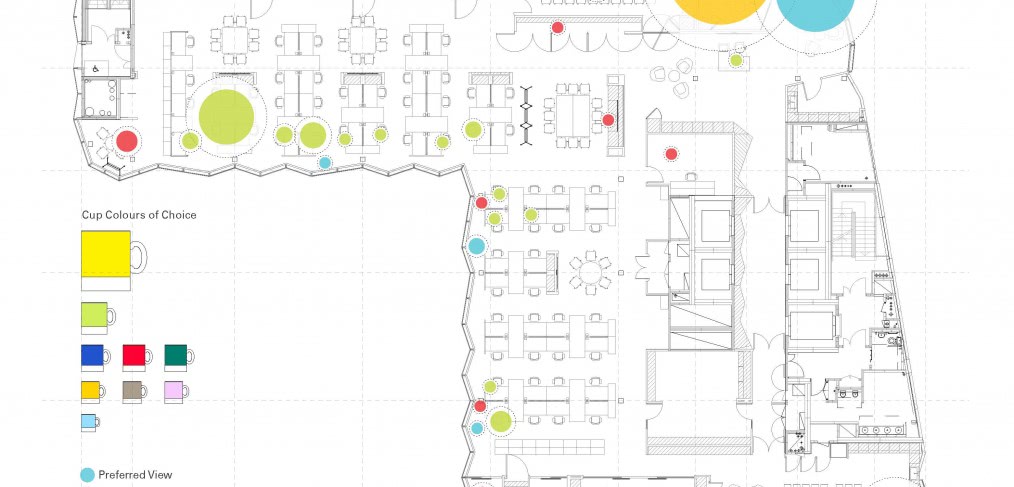
Pursuit of Happiness (Part 2)
From the very beginning of my Kagan proposal, I had a feeling that measuring the effect that architecture has on happiness would be difficult. I was right. As I stated in my last post, my main research objective is to travel to a selection of the happiest and saddest cities in the US and investigate any architectural correlations to these statistics. While preparing for my travels to the US, I am in the process of conducting miniature surveys here in London, particularly within the RTKL London office. I am hoping that this will give me some pointers in deciding what techniques to employ in America.
London ranks pretty averagely on most happiness polls, therefore it must be dealt with in a slightly different way than the American cities that I identified. Trying to find out if and why someone is happy is not a straightforward task. Mappiness, a study at London School of Economics, used an iPhone app to ask people to rate their subjective level of happiness, in addition to a few control questions about their whereabouts and activities. I interviewed the creator of the app, Dr George McKerron and he explained that the main result that stands out is that people are generally happier when they are outdoors. It also provides interesting graphs of who you are happiest with and what you are happiest doing. My statistics showed that I was the happiest when eating. The problem is that this app does not attempt to map spatial qualities further than that, so my task still remains unsolved.
My survey of Londoners is still in the making, but I have asked people to draw simple sketches of their perception of a certain area or time in the city. I am working on the premise that London is not particularly happy. As a result, I am developing alternative methods to map out spaces where people want to be. I will also interview my subjects with a range of questions regarding local architecture and urban planning. By using similar questionnaires in England and America, I will perhaps discover a discrepancy in results between the two.
In an initial attempt to gain an understanding of how space and architecture affects us, I have taken RTKL’s London office as a micro-city, polling its occupants on issues that only relate to this building. I will not ask my colleagues at RTKL directly if they are happy, as I doubt I would get completely truthful answers. It is almost easier to talk to a stranger about one’s happiness (or lack thereof), so I am hoping that this will be less of an issue in the US. I am working towards formulating a set of questions or drawing tasks that are harder to decipher the meaning of, which might yield more unexpected answers. I am interested in seeing how different people perceive the same space, and what parts of it they find pleasant. In this preliminary round of questions, I asked my colleagues the following:
1. Which is your favourite meeting room?
2. If you had 5 minutes to look out at the view, which window would you choose?
3. If you could pick any desk in the open plan office, which would it be?
4. If you had to sleep in the office one night, where would you sleep?
5. Which of our Pantone coloured cups is your first choice?
I had a lot of fun with this task and received many interesting responses. I have mapped out the trends on a floor plan of our office, which shows that most people clearly want a desk by the window where no one walks past to see your screen. The most popular cup colour was yellow. My personal favourite, lime green, came in second. The spaces where people felt comfortable sleeping proved to be more individual, with a range of strange places popping up. Without asking people directly about happiness, I found some indicators and common denominators of the spatial features that RTKL staff members find desirable.
I will be travelling across the US in September, and these studies in London and in the office will inform my research process there. While making as many preparations as possible, I am still looking forward to the many unpredictable parts that I will surely encounter during my travels.


Hey Nora – great article. I like that you start out with a micro-scale survey (office building) and then plan to move on to more of a macro-scale (city). Looking forward to seeing your results! One thing you might want to ask your survey participants is how easy it is, or how often they can escape the city. Cities can make people happy, but the ability to get away from it is also pretty important. For example, I went to school in Vermont and spent a lot of time in Burlington. One of the best things about Burlington was that it was a (small) city that had all of the typical city stuff (activities, people, nightlife, etc.) but it was also very easy to get away from. There were lots of ski resorts and the lake and other things to do outside of the city. It allowed the city to have a character, but also allowed for easy reprieve. I wonder if all the cities you visit will have “escape” in close proximity?